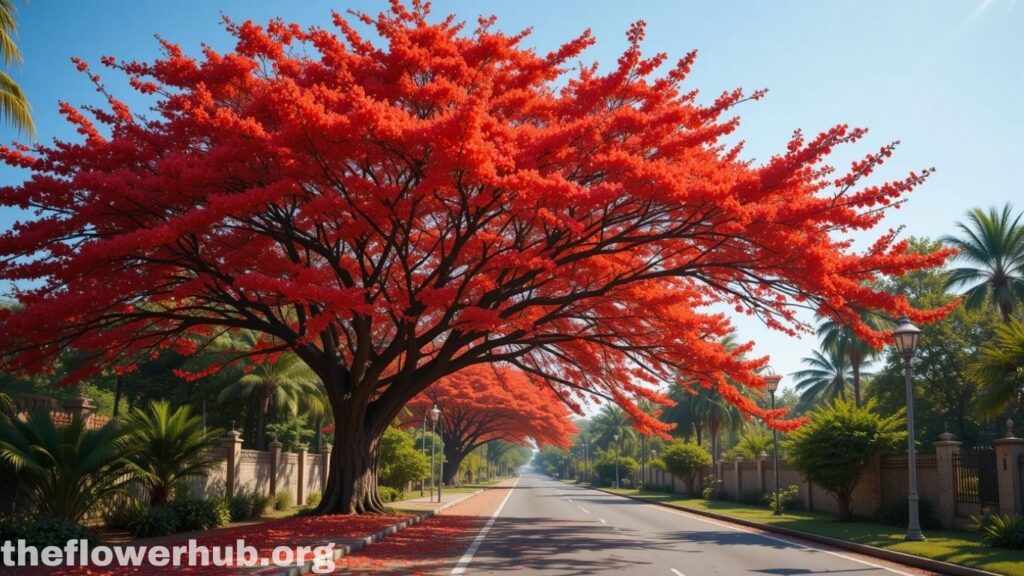Introduction
There are few flowers that are able to capture the eye and the heart, like the Gulmohar flower does. The Gulmohar tree, also called as Delonix regia, lights up with a riot of fiery red accents, including orange bursts, at the height of summer, adding a patchwork of stunning red and orange to the landscapes of tropical and semi-tropical countries. Loved for its fern looking leaves and beautiful flowers, the Gulmohar flower is not just a treat to the eye — it is of cultural, ecological, and horticultural value of various countries.
In this blog, let’s reveal seven incredible facts about the Gulmohar flower – from where it is originated to meaning and benefits and how to take care of it. If you’re a tree-hugger, you’ll go nuts too!

Table of Contents
Table: Overview of the Gulmohar Flower
| Feature | Details |
|---|---|
| Botanical Name | Delonix regia |
| Common Names | Gulmohar, Flame Tree, Royal Poinciana |
| Native Region | Madagascar |
| Blooming Season | Late spring to early summer |
| Flower Colors | Fiery red, orange, and occasionally yellow |
| Tree Size | 10 to 15 meters (33 to 50 feet) tall |
| Lifespan | 30 to 50 years |
| Symbolism and Cultural Significance | Passion and beauty |
| Sunlight | Full sunlight |
| Soil | Well-draining, slightly acidic to neutral |
Origins of the Gulmohar Flower: A Present from Madagascar
Gulmohar (Daydream) The origin of the Gulmohar flower is the dry deciduous forests of Madagascar and it grows wild. It is botanically called Delonix regia, and was subsequently planted in tropical and subtropical regions for ornamental purposes.
- Scientific Family: Fabaceae (Legume family)
- Genus: Delonix, which translates into “visible claw,” an allusion to the plant’s claw-shaped petals
From Madagascar, the tree spread to the Caribbean, India, Southeast Asia and Africa — where it often became the showpiece of urban parks, gardens and even roadsides.
The fact that the Gulmohar can grow well in diverse habitats, makes it a great wall plant. It does best in well-drained soil and full sun, but can tolerate drought once it takes hold. This durability, along with its unsual appearance, has made it popular in civic plantings.
Culture and Landscapes The Indian Gulmohar Flower
The Gulmohar flower is much significant, aesthetically and culturally, in India. Its flamboyant hue is generally representative of summer, reinvention and happiness.
🌺 Symbolism in Indian Culture
- Represents fiery passion and love
- Observed in poetry, painting, and ancient writings
- Often planted in schoolyard, garden, in temple precincts
It is the theme of many a nostalgic story and poem reminiscing the joys of youth and early romance. Students often have happy memories of picking up the fallen petals in brilliant colors after school.
The blooming period of Gulmohar indicates the advent of Indian summers. It’s blooming during school vacations, mango season and hot tropical days, deeply woven into generations of memories.
Gulmohar Tree vs. Other Flowering Trees
Comparing the beautiful Gulmohar with some other popular flowering trees in terms of beauty, shade and flowering time:
| Tree | Flower Color | Good For | Flowering Time |
|---|---|---|---|
| GULMOHAR | Red / Orange | Summer color, urban décor | Late spring-summer |
| JACARANDA | Purple / Lavender | Romantic vibe, soft hue | Spring |
| AMALTAS | Bright Yellow | Traditional decor | Mid-summer |
| SILK COTTON | Pink/Red | Wildlife attraction | Early spring |
The Gulmohar is easily recognisable by its fiery red petals set against the forest of green leaves, and with the glorious long flowering period. It provides a microhabitat for insects and birds and presents a refreshing respite from intense summer heat.
Applications and Benefits of the Gulmohar Flower and Tree
The Gulmohar tree itself (along with its flower) although decorative and ornamental is not entirely unproductive:
Shade Provider
- Broad, spreading canopy
- Great for lining driveways and schools
- F: Cools the ambient air in order to minimize the UHI effect
Soil Enrichment
- Gulmohar along with genus Caesalpinia is in the family is the family FabaceaeCaesalpinioideae.
- Improves surrounding soil quality naturally
- Can help rehabilitate degraded lands
Medicinal Uses in Traditional Healing
- Uses Bark and leaves used in traditional medicine
- Traditionally used for:
- Anti-inflammatory purposes
- Fever reduction
- Wound healing
Pollinator Attraction
- Attracts bees, butterflies, and birds
- Boosts local biodiversity
- Supports the establishment of healthy ecosystems in urban environments
Gulmohar Flower Meaning and Symbolism Around the World
The Significance of the Gulmohar Flower In different cultures, the Gulmohar flower is associated with a great deal of symbolism.
| Region | Symbolism |
|---|---|
| India | Summer, vividness, love |
| Caribbean | Royalty, frivolity, exuberance |
| Africa | Hope, life, reccurence |
| Vietnam | “Flame of the student” (as the symbol of the youth) |
It is generally thought of as a symbol of change and passion. In literature and the visual arts, the flower is frequently used to represent tropical desire or fugitive beauty. Its bright colors are meant to conjure feelings of energy, motivation and, perhaps, fleeting time — much like its short-lived but potent bloom.
How to Grow and Maintain a Gulmohar Tree
Gulmohar tree growing is not very difficult; however, if you live in cold areas you can grow the plant in a pot instead and take the plant indoors during severe winter. But it needs to be nurtured in childhood.

Sunlight
- Requires full sun (6-8 hours per day)
Soil
- Loamy, moderately fertile soil that drains well.
- Avoid overly waterlogged areas
Watering
- Moderate watering in early stages
- Drought-tolerant once mature
Pruning
- Prune young trees to shape.
- Remove dead branches post-monsoon
Propagation
- Mostly by seeds
- Soak seeds in warm water toward evening time and allow to dry a few hours before planting for 24 hour soaking may cause seed damage.
- Can also propagate via cuttings
The Gulmohar flowers are heat and light loving, making them perfect for tropical and sub-tropical gardens. It should be sited where its spreading roots will not damage sidewalks or underground structures.
Ecological Effects of the Gulmohar Flower Tree
Sure, it’s gorgeous, but… The fuck?
Pros
- Shading, lessens urban heat island effects
- Boosts oxygen levels
- Attracts pollinators
⚠️ Cons
- Invasive in several areas, may overtake natives
- Surface roots may damage pavements or drains
The minor invasion notwithstanding the Gulmohar flower is to this day popular in municipal landscaping for its spectacular seasonal display. However, its advantages certainly outweigh the disadvantages as long as it’s sited correctly.
FAQs
Q1: In what season does Gulmohar flower bloom?
A: That depends on the local climate, though itusually blossoms between April and June.
Q2: Can we plant Gulmohar in pot or container?
A: Its size and root system does not make it the best candidate for pots. It is most passionate about being planted in the ground.
Q3: Can I plant a Gulmohar tree in my home garden?
A: Yes, assuming there’s enough space. It’s ideal for larger gardens, however it may be too large for smaller backyards.
Q4: When Gulmohar tree flowering period?
A: It generally flowers 4-5 years if grown from seed.
Q5 : Can we eat or cook Gulmohar flowers?
A: The flowers are inedible and are mainly for decorative purposes.
Conclusion
The Gulmohar flower is more than a tree — it is a seasonal spectacle, a cultural icon and a promise of tropical exuberance. With its flame-shaped flowers, and spreading canopy, it commands attention and inspires the imagination. From city parkways to neighborhood backyards, this iconic tree still paints our lives with beauty and provides cool, summer shade.
If you hope to grow a Gulumohur tree, you are going to be giving your neighborhood a stunning display each summer. And if you’re marvelling at the Gulmohar from afar, now you know — it is not just a flower, but a story that grows in the heart of nature, culture and love.
